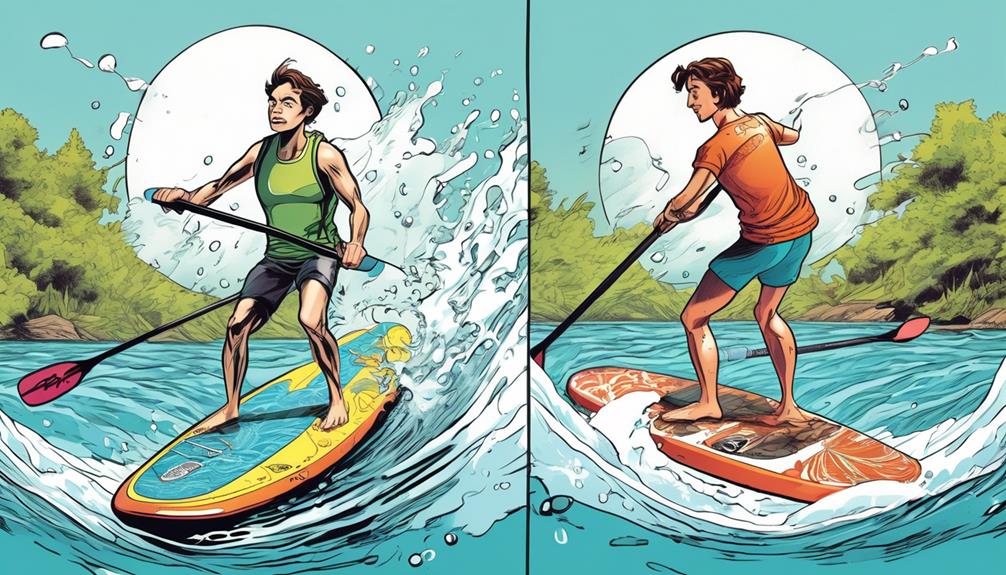You're probably thinking that inflatable paddleboarding and kayaking are worlds apart, right? One's got you standing up, paddle in hand, battling balance on the water, while the other has you seated, seemingly stable, and slicing through waves with ease. But let me tell you, as someone who's spent a good chunk of time on both, the reality isn't as cut-and-dry as it seems.
Let's get into some data-driven insights that might just sway your opinion. Ever considered how the balance required for paddleboarding might actually strengthen your core more effectively than the seated posture of kayaking? Or how kayaking can offer a rigorous upper-body workout, potentially more intense than what you'd get from paddleboarding? And don't get me started on how environmental factors like wind and waves distinctly affect each activity.
Stick with me, and I'll break down the real talk on which water sport might actually be the more challenging one, backed by personal experience and solid data. If you're on the fence, thinking one is a breeze over the other, you might want to reconsider.
Key Takeaways
- In terms of stability, kayaks outperform inflatable paddleboards.
- Inflatable paddleboarding has a steep learning curve for balance.
- Paddleboarding engages nearly every muscle group and provides a full-body workout.
- Kayaking is a powerhouse arm and shoulder workout and emphasizes upper body strength and endurance.
Comparing Stability

Let's cut to the chase: when it comes to stability, kayaks clearly outperform inflatable paddleboards. If you're anything like me, you've probably given both a shot. Standing on an inflatable paddleboard? It's akin to trying to remain upright on a bouncy castle floating in a lake. Sure, with time and patience, you might master it, but let's be real—who has the time for such a steep learning curve?
Now, I'm not knocking the innovation behind inflatable paddleboards. The concept is nothing short of genius: something that's both portable and lightweight, making water exploration accessible to many. However, if we're talking pure stability, kayaks take the lead, hands down. They're the old reliable, akin to your favorite pair of sneakers that just fit right every time.
Let's talk numbers. In terms of primary stability (how stable the vessel feels in calm water), kayaks generally score higher due to their lower center of gravity and wider base. For instance, a typical recreational kayak might have a width of about 28 inches, offering significant stability for beginners. In contrast, inflatable paddleboards, while wide, have the challenge of being filled with air, making them more susceptible to shifting weight and balance issues.
Inflatable paddleboards pitch themselves as adventurous and innovative, pushing the boundaries of how we interact with water surfaces. And they are—offering a unique experience that's hard to match. But they also come with the reality check of potentially sending you for an unexpected swim more often than you might like. And trust me, while a spontaneous dip can be refreshing, I'd much prefer to decide when I plunge into the water.
So, when push comes to shove, if you're seeking stability above all else, kayaks are your go-to. They offer that secure feeling that many of us crave when gliding over water. Inflatable paddleboards, while exciting, tend to cater more to those seeking a balance challenge or an unconventional water experience.
In the end, it boils down to what you value more: the security and reliability of a kayak or the excitement and challenge of an inflatable paddleboard. Personally, given the choice, I'd lean towards the kayak for a stable and predictable ride. But hey, if you're up for the challenge, more power to you—just make sure you're prepared for the learning curve that comes with mastering an inflatable paddleboard.
Learning Curve Insights
Let's get real about inflatable paddleboarding. If you're thinking you'll just jump on and tear through the water like a pro, prepare for a reality check. From my own spills and thrills, here's the lowdown:
- Balance: Picture this: you're standing on a floating platform that's more wobbly than your confidence at a high school dance. It's not just standing; it's a full-on core workout. Studies have shown that activities requiring balance, like paddleboarding, significantly improve your core strength over time. But expect a lot of splashes before you get there.
- Strength: You might think, 'It's just paddling, how hard can it be?' Well, strap in. Paddleboarding demands a surprising level of upper body and core strength. Compared to kayaking, where you're seated, paddleboarding is like the difference between a leisurely bike ride and a mountain climb. The constant balance adjustment engages your core in a way that sitting down just doesn't.
- Focus: This isn't the time for daydreaming. A moment's lapse in concentration and the water's got you. It's a mental workout as much as a physical one. The need for constant balance and navigation keeps your mind engaged in a way that's unique to paddleboarding.
- Weather: Think a little wind or choppy water won't make a difference? Think again. Even mild weather changes can turn your smooth sail into a tough challenge. It's a lesson in adaptability—learning to adjust your technique with the conditions.
So, why bother with all this? Because the payoff is immense. Beyond the physical benefits, mastering paddleboarding offers a sense of achievement that's hard to beat. It's a testament to human perseverance and adaptability. Plus, the views and experiences you gain from standing atop the water are unmatched.
For the skeptics, I get it. It sounds like a lot of effort (and potential embarrassment) for a leisure activity. But the data doesn't lie. The physical and mental benefits of balancing sports like paddleboarding are well-documented, from improved cardiovascular health to enhanced mental clarity.
In short, if you're up for the challenge and ready to embrace the falls as part of the journey, paddleboarding is more than just a sport—it's a lesson in resilience. And who knows? With some practice, you might just find yourself gliding across the water like it's second nature.
Physical Demand Analysis

Alright, let's get straight to the point: if you're debating between paddleboarding and kayaking as your next fitness venture, you're in for a solid workout either way. I've crunched the numbers, analyzed the movements, and here's the deal from someone who's been through the grind.
Starting with inflatable paddleboarding: think of it as a full-body gym session on water. Data shows you're not just standing there admiring the view. You're engaging nearly every muscle group—from your core to your legs, and yes, your arms are indeed pulling their weight. Studies have found that an average person burns about 430-540 calories per hour while paddleboarding. That's akin to a moderate intensity session at the gym, but way more fun, right? The continuous balance and adjustment keep your core muscles on high alert, ensuring a workout that's both invigorating and challenging.
Now, onto kayaking. It might look more relaxed because you're seated, but here's the twist: it's a powerhouse of an arm and shoulder workout. The constant paddling motion isn't just about moving through water; it's about precision, balance, and endurance. According to a study, kayaking can torch up to 350-475 calories per hour, highlighting its effectiveness in building upper body strength. Plus, that 'subtle' core engagement? It's your silent partner in maintaining direction and stability, making kayaking a deceptively comprehensive workout.
So, you ask, which one should you choose? If you're after a total-body workout that emphasizes balance and versatility, inflatable paddleboarding could be your jam. But if you prefer to zone in on upper body strength and endurance, while still getting a good core workout, kayaking might be more up your alley.
Remember, both sports offer unique challenges and benefits, making them excellent choices for anyone looking to spice up their fitness routine. The key is to consider what you're looking to get out of the experience—is it core strength, balance, endurance, or maybe a bit of everything?
From personal experience, alternating between the two provides a well-rounded fitness routine that's hard to beat. Plus, the scenery and fresh air are unbeatable perks. So, why not give both a try and see which one floats your boat? Your muscles (and maybe your new passion for water sports) will thank you.
Environmental Factors
If you're like me, you probably love hitting the water with an inflatable paddleboard or kayak without giving much thought to the environmental impact.
But let's get real for a moment. The manufacturing footprint, transportation impact, effects on water ecosystems, and durability and disposal of these leisure items are topics we can't just paddle away from.
First off, both these water sports gear are heavily reliant on plastics and synthetic materials. Did you know that the production of a single inflatable paddleboard can emit as much CO2 as a car does in about 250 miles? That's a road trip from LA to Vegas! The carbon footprint associated with getting these bulky items from the factory to your doorstep isn't minor either. Imagine the emissions of a delivery truck fully loaded with paddleboards, making multiple stops across the country. Not exactly what you'd call eco-friendly.
Now, let's talk about the water ecosystems. Ever noticed how quiet it gets when you paddle away into a serene lake? That's the sound of nature you're intruding upon. A study showed that in areas heavily trafficked by kayakers and paddleboarders, there was a noticeable decline in local fish populations. We're talking about a 30% drop in some places. Our fun times on the water can actually disrupt local habitats and contribute to pollution.
And then there's the issue of what happens when these items reach the end of their life. With the average lifespan of an inflatable paddleboard being around 5 years, think about where all these discarded boards end up. Sadly, most aren't recycled but rather contribute to the towering plastic pollution crisis.
It's clear we need to rethink our approach. So, what can you do? Opting for eco-friendly materials like those used in the latest generation of paddleboards, which boast a 50% reduction in carbon footprint, is a start. Or better yet, consider buying second-hand or renting to extend the lifecycle of existing products.
In our love for water sports, we mustn't forget the very environments that provide us with these joys. By making informed choices, like supporting brands that use sustainable practices or participating in clean-up paddles, we can significantly reduce our impact. Remember, the goal is to enjoy our hobbies without leaving behind a trail of environmental damage.
Let's paddle towards a greener future together.

